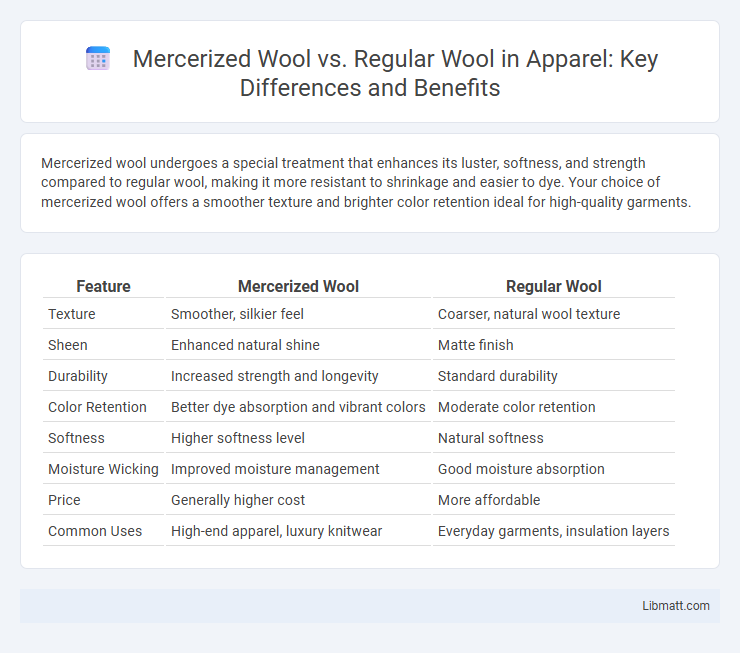Mercerized wool undergoes a special treatment that enhances its luster, softness, and strength compared to regular wool, making it more resistant to shrinkage and easier to dye. Your choice of mercerized wool offers a smoother texture and brighter color retention ideal for high-quality garments.
Table of Comparison
| Feature | Mercerized Wool | Regular Wool |
|---|---|---|
| Texture | Smoother, silkier feel | Coarser, natural wool texture |
| Sheen | Enhanced natural shine | Matte finish |
| Durability | Increased strength and longevity | Standard durability |
| Color Retention | Better dye absorption and vibrant colors | Moderate color retention |
| Softness | Higher softness level | Natural softness |
| Moisture Wicking | Improved moisture management | Good moisture absorption |
| Price | Generally higher cost | More affordable |
| Common Uses | High-end apparel, luxury knitwear | Everyday garments, insulation layers |
Introduction to Mercerized Wool and Regular Wool
Mercerized wool undergoes a chemical treatment that enhances its luster, strength, and dye absorption compared to regular wool. This process results in a smoother, more durable fabric with vibrant colors and a silk-like sheen. Regular wool retains its natural texture and breathability but lacks the polished finish and increased tensile properties found in mercerized wool.
What Is Mercerized Wool?
Mercerized wool undergoes a specialized treatment involving chemical processing that enhances the fiber's strength, luster, and dye absorption compared to regular wool. This process results in a smoother texture, increased durability, and vibrant coloration, making mercerized wool ideal for high-quality textiles and garments. Unlike untreated wool, mercerized wool maintains its shape better and offers improved resistance to shrinkage and pilling.
Key Characteristics of Regular Wool
Regular wool features natural crimp and elasticity, providing excellent insulation and moisture-wicking properties ideal for cold weather. It often contains lanolin, which enhances water resistance but may cause slight itchiness for sensitive skin. Your choice of wool depends on desired texture, durability, and comfort, with regular wool offering a more traditional, breathable fabric.
The Mercerization Process Explained
Mercerized wool undergoes a chemical treatment with sodium hydroxide that alters the fiber structure, increasing fiber swelling and surface smoothness. This process enhances wool's luster, strength, and dye absorption, resulting in richer colors and a more durable fabric compared to regular wool. Mercerized wool also offers improved moisture-wicking properties and reduced shrinkage, making it more suitable for high-quality apparel and textiles.
Texture and Appearance Comparison
Mercerized wool features a smoother texture and a subtle sheen due to the mercerization process, which enhances fiber strength and luster, setting it apart from regular wool's naturally matte and slightly coarse feel. Regular wool tends to have a more textured surface with visible fibers, contributing to its classic, rustic appearance. Your choice between the two will impact the garment's visual appeal and tactile comfort, with mercerized wool offering a polished, refined look suitable for formal wear.
Durability and Longevity
Mercerized wool undergoes a special treatment that enhances fiber strength, making it more durable and resistant to wear compared to regular wool. This process also helps maintain the fabric's integrity over time, extending the longevity of your garments. Choosing mercerized wool ensures a longer-lasting, high-quality product ideal for frequent use.
Care and Maintenance Differences
Mercerized wool offers enhanced durability and resistance to shrinking compared to regular wool, making it easier to care for with less risk of deformation during washing. Its smoother fibers repel dirt and moisture more effectively, allowing for less frequent cleaning and gentler washing methods. Regular wool requires careful handling, often needing hand wash or dry cleaning to maintain its softness and shape, while mercerized wool can tolerate more relaxed maintenance routines without compromising quality.
Cost and Availability
Mercerized wool generally commands a higher price due to the additional processing involved, making it less accessible in mainstream markets compared to regular wool. The specialized finishing enhances softness and sheen, which appeals to premium textile segments, but limits widespread availability. Regular wool remains more affordable and widely stocked, favored for its natural texture and versatility in mass production.
Best Uses and Applications
Mercerized wool offers enhanced luster, strength, and moisture-wicking properties, making it ideal for high-performance sportswear, luxury knitwear, and premium fashion garments. Regular wool excels in insulation and breathability, making it suitable for winter clothing, heavy outerwear, and durable everyday apparel. Mercerized wool's smooth texture supports finer, more detailed fabrics, while regular wool provides superior warmth and natural resilience.
Conclusion: Choosing Between Mercerized and Regular Wool
Mercerized wool offers enhanced luster, increased strength, and improved dye absorption compared to regular wool, making it ideal for garments requiring durability and vibrant colors. Regular wool retains natural breathability and insulation properties, providing superior warmth and comfort for everyday wear. Your choice between mercerized and regular wool depends on whether you prioritize aesthetic appeal and durability or natural texture and insulation.
Mercerized wool vs regular wool Infographic

 libmatt.com
libmatt.com